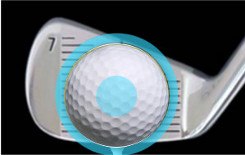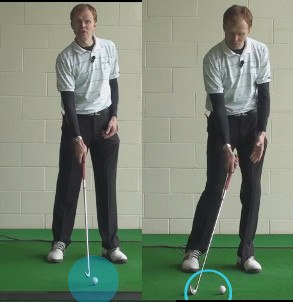
There's only one piece of equipment you're guaranteed to use for every shot on the course: the golf ball. It’s essential to understanding what the ball does when hit, and why it does it.
I know what you're thinking: Isn't there already enough to think about in my golf swing? Do I have to pay attention to what the ball does after I’ve struck it? Knowing what causes the golf ball to travel a certain way can help cure any problems you may be having with your game.
While it's true that your work is done once the ball is in the air, paying attention to its flight will give you an idea of what went right or wrong in your swing. Obviously, this is need-to-know information.

Here are some common mishits and what you can instantly learn from them:
Topping the ball or hitting it “thin”: Hitting the middle or top of the ball with the bottom of the club usually results in a very low shot – sometimes not even off the ground. Causes include playing the ball too far back in your stance (to the right, for a right-hander), poor balance, improper weight shift, and lifting the lead shoulder and head before impact.
Hitting the ball “fat” or “heavy”: The opposite of a topped shot, with the club hitting the ground before the ball. The ball may get airborne, but will not go as you want. If you often hit the ball fat, your posture could be too hunched over, the ball positioned too far forward in your stance (closer to the left foot of a right-hander), or too much of your balance on the right foot.

Hitting the ball on the club’s toe or heel: Striking the ball on the end (toe) of the club could mean you’re raising your body during the swing, pulling the club away from the ball. The opposite is hitting the heel of the club (the part closest to the shaft), which may mean you’re leaning forward during the swing. Both issues can be fixed by setting up with good posture, then maintaining the same angle of your spine throughout the swing.
“Shanking” the ball: Similar to a heel hit, a “shank” is when the ball actually strikes the hosel (where the shaft enters the clubhead) and shoots straight right. The easiest way to correct this is to stand slightly farther from the ball. Also, make sure you’re pulling the club straight down the target line on the takeaway, not to the inside of the golf ball.
Understanding what the golf ball did and why it behaved a certain way after being struck is a key skill for golfers. Here are some factors to consider and steps to help you analyze and understand the ball's behavior:
- Observation: Watch the flight of the ball from the moment of impact until it lands. Observe its initial direction, trajectory, height, curvature, and distance traveled. Pay attention to how the ball interacts with the ground (e.g., bouncing, rolling) after landing.
- Ball flight laws: Familiarize yourself with the basic principles of ball flight laws in golf. The two main factors that influence the ball's flight are the clubface angle (face direction at impact) and the club path (the direction the clubhead is moving at impact).
- Shot shape analysis: Determine the shot shape (draw, fade, straight, hook, slice) based on the observed flight. This can provide clues about the clubface angle and club path at impact.
- Impact factors: Assess the factors that affect the ball's behavior at impact:
a. Clubface angle: The position of the clubface at impact influences the initial direction of the ball. A closed face may cause a hook, an open face may cause a slice, and a square face may result in a straight shot.
b. Club path: The path of the clubhead as it approaches the ball affects the ball's curvature. An inside-to-out path typically produces a draw or hook, while an outside-to-in path often leads to a fade or slice.
c. Sweet spot contact: Striking the ball on the clubface's sweet spot tends to produce more consistent and accurate shots. Off-center hits may result in reduced distance, directional deviations, or altered spin.
- Swing analysis: Reflect on your swing mechanics and technique to identify potential causes of the ball's behavior. Factors such as swing plane, swing speed, angle of attack, weight shift, and grip may contribute to the ball's flight pattern.
- Environmental conditions: Take into account external factors like wind speed and direction, course conditions (e.g., firm or soft fairways, thick rough), and weather conditions (e.g., temperature, humidity) as they can influence ball flight and behavior.
- Shot outcome: Consider the outcome of the shot in relation to your intended target. Did the ball end up where you wanted it to go? Assess the differences between the intended shot and the actual shot to gain insights into any adjustments needed.
- Learn from experience: Over time, as you gain more experience and analyze your shots, you'll start to recognize patterns and understand how various swing and impact factors affect the ball's behavior. This knowledge will help you make adjustments and improve your game.
It's worth noting that understanding ball flight and shot analysis can be complex, and sometimes it may require the guidance of a golf instructor or coach. They can provide expertise, video analysis, and feedback to help you better understand your ball flight patterns and make necessary adjustments to improve your performance.
For More information on ball flight click here
Golf Ball Videos:
– Compression Video
– Spin Video
– Dimples Video
– Golf Ball Brands Video
– Titleist Video
– Understanding Spin Video





